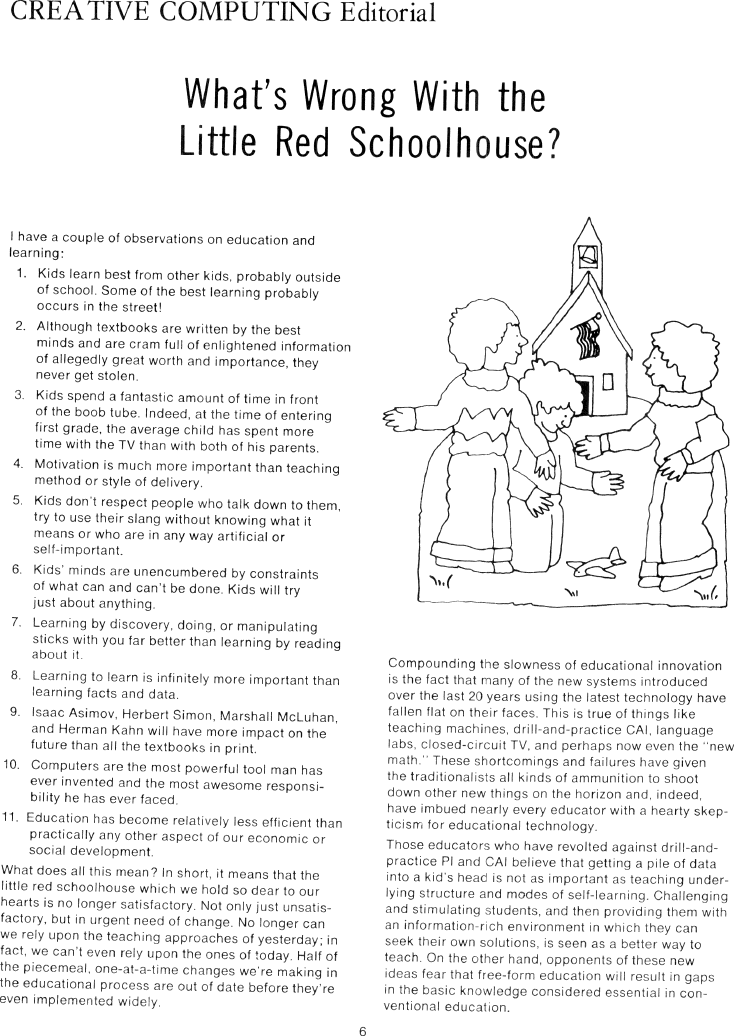The Best of Creative Computing Volume 1 (published 1976)
What's Wrong With the Little Red Schoolhouse? (Observations on education and learning)

CREATIVE COMPUTING Editorial
What's Wrong With the
Little Red Schoolhouse?
l have a couple of observations on education and
learning:
1. Kids learn best from other kids, probably outside
of school. Some of the best learning probably
occurs in the street!
2. Although textbooks are written by the best
minds and are cram full of enlightened information
of allegedly great worth and importance, they
never get stolen.
3. Kids spend a fantastic amount of time in front
of the boob tube. Indeed, at the time of entering
first grade, the average child has spent more
time with the TV than with both of his parents.
4. Motivation is much more important than teaching
method or style of delivery.
5. Kids don't respect people who talk down to them,
try to use their slang without knowing what it
means or who are in any way artificial or
self-important.
6. Kids' minds are unencumbered by constraints
of what can and can't be done, Kids will try
just about anything.
7. Learning by discovery, doing, or manipulating
sticks with you far better than learning by reading
about it.
8, Learning to learn is infinitely more important than
learning facts and data.
9. Isaac Asimov, Herbert Simon, Marshall McLuhan,
and Herman Kahn will have more impact on the
future than all the textbooks in print.
10. Computers are the most powerful tool man has
ever invented and the most awesome responsibility he has ever faced.
11. Education has become relatively less efficient than
practically any other aspect of our economic or
social development.
What does all this mean? In short, it means that the
little red schoolhouse which we hold so dear to our
hearts is no longer satisfactory. Not only just unsatisfactory, but in urgent
need of change. No longer can
we rely upon the teaching approaches of yesterday; in
fact, we can't even rely upon the ones of today. Half of
the piecemeal, one-at-a-time changes we're making in
the educational process are out of date before they're
even implemented widely.
[image]
Compounding the slowness of educational innovation
is the fact that many of the new systems introduced
over the last 20 years using the latest technology have
fallen flat on their faces. This is true of things like
teaching machines, drill-and-practice CAI, language
labs, closed-circuit TV, and perhaps now even the “new
math.” These shortcomings and failures have given
the traditionalists all kinds of ammunition to shoot
down other new things on the horizon and, indeed,
have imbued nearly every educator with a hearty skepticism for educational
technology.
Those educators who have revolted against drill-and-practice Pl and CAI believe
that getting a pile of data
into a kid's head is not as important as teaching underlying structure and modes
of self-learning. Challenging
and stimulating students, and then providing them with
an information-rich environment in which they can
seek their own solutions, is seen as a better way to
teach. On the other hand, opponents of these new
ideas fear that free-form education will result in gaps
in the basic knowledge considered essential in conventional education.


